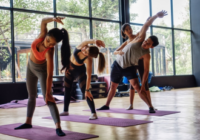Are you wondering exactly how you can begin to teach yoga and turn it into a profitable business? Then look no further beyond this article because we’ll be going in-depth about how to start your very own yoga training business and what tools you need to get yourself running.
Let’s get straight to it.
How to Teach Yoga
To begin teaching yoga to a student, especially when it’s a newbie its best to follow three rules
- Keep it Real
- Keep it Simple
- Keep it Light
You should be aiming to give students the best experience possible, You need them to feel good so they inevitably want to come back to you.
1.) Short and Sweet: Stick to a 60-minute class.
You’re going to be working with a lot of beginners in the yoga training business and they can only handle so much before it becomes overwhelming. They’re in a position where they’re taking in so much new information on a physical level that they might lose interest.
Keeping them engaged and focused for the whole class should be your goal, do that and you’ve done a great job already. It’s just natural, our way of life is mostly geared towards the 1-hour lunch break or the 1-hour class etc. Anything more than this can usually be intimidating or just seem like a plain waste of time, especially if you spend 4 of it laying on the floor.
2.) Teach Students How to Breathe.
It’s best to remind students at other appropriate times to breathe throughout the class. All you just need to do is get them in the groove of yogic breathing throughout their practice. Keep it simple
3.) Share Just One Philosophical Aspect Per Class.
The majority of beginners are there mostly for the physical aspect of the practice and may not be ready or even want to hear the philosophy. Pique the interest of those not so ready and satisfy the curiosity of those interested by giving a solid nugget.
Spend just a few minutes on one single point and move on to the movement and awareness of movement. If possible refer back to the nugget of wisdom later in the practice or in savasana. Less is more and often times it can be profound. Keep it light
4.) Demonstrate as Little as Possible.
Demonstrate as little as possible to better cultivate that inner awareness from the beginning. Students will be in a room, looking at you and you will have to quite a bit. Do try and take the training wheels off for a while, this will set them up well for the next class.
5.) Keep The Savasana Short and Guided.
Beginners are often times challenged by the Savasana. It’s probably the hardest part of the class for some students. Give them a helping hand by guiding them through the Savasana. Eventually your verbal cues will no longer be needed and they’ll enjoy them unguided.
6.) Teach The Staple Yoga Poses.
Teach students the common yoga poses that can be found in almost any hatha or vinyasa yoga class. The best way to teach modifications, is to teach the modification first as a stage of getting into the pose, and then offer the option of moving into the full pose. By doing this, everyone is moving together and then some move on while others stay.
Here is a list of staple beginner yoga poses for a class to get you started (everything is too much for a 1 hour class, use only a mix of few per class)
- Mountain Pose
- Warrior 1
- Warrior 2
- Triangle Pose
- Downward Dog
- Tree pose
- Wide-Legged Forward Bend
- Hand to Big Toe Pose
- Chair Pose
- Revolved Chair
- Revolved Side Angle
- Revolved Triangle
- Boat Pose
- Malasana
- Seated Twist
- Wide Leg Forward Fold
- Locust Pose
- Savasana
- Seated Forward Fold
- Crow Pose
- Side Plank
Whether you’re teaching an introductory course or an ongoing weekly class. It’s best to teach the same class every week for a few weeks in a row and gradually change a few poses in your routine. People like familiarity and a sense of mastery, and they also love being able to measure progress. Give them an opportunity to do this. Set your students up for success and teach them the foundational poses and concepts of yoga. Keep it simple, keep it real and keep it light.
We’d love to know your thoughts about this topic. Kindly leave a comment below 🙂




